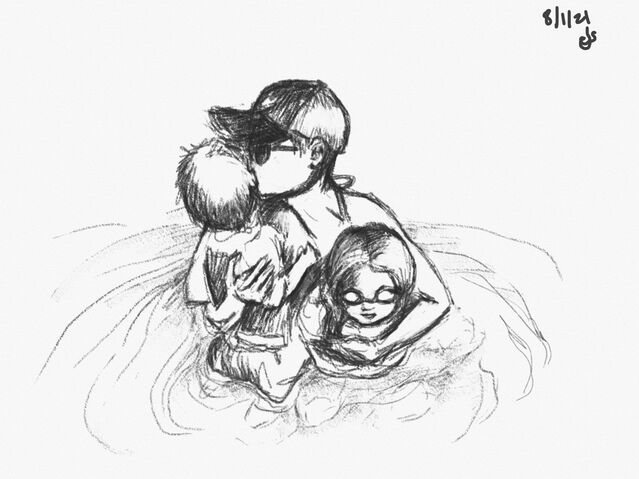Family Dynamics
How to Handle Sibling Fights
Five steps to ending conflict with compassion.
Posted August 11, 2021 Reviewed by Ekua Hagan
Key points
- Kids can learn to respond to conflict appropriately with a little guidance from adults.
- Logic is only effective once all brain powers are back online, after the emotional surge has ended.
- Conflict and repair are both important parts of a strong relationship.
I’m listening to a mindfulness podcast against the backdrop of my two children who are borderline assaulting each other on the back patio. The big one is kicking the little one’s tricycle and now he’s poised to bludgeon her with a toy dump truck. Joseph Goldstein’s voice hums in the background, warning us against wishing things were different. This, he says, is the enemy of acceptance.
My kids irritate me the most when I’m trying to multitask—in this case, supervising them while listening to an interview that will make me more compassionate, d*mn it! I slam my phone down and say, again, “Stop it! Stop it, guys, seriously! Stop it right now!”
The irony is not lost on me.
By fighting, they are certainly communicating, but they don’t yet have the words or social-emotional wherewithal to do it “appropriately.”
Part of the solution is simply time: We sit back and accept where kids are in the developmental rollercoaster. We wait for their mushy little frontal lobes to pop online. And we calmly remind ourselves that they can’t reasonably be expected to share possessions until around age 4, anyway.
In the meantime, though, sometimes things do need to be different. Kids learn mostly from watching adults and then trying things out on their own, but at some point, they need explicit input and intervention from adults. They can’t be expected to completely manufacture conflict resolution skills from thin air.

In case you missed the social-emotional learning train like I did by being a child of the “You can do anything you want to” '90s, with “If you want it done right, do it yourself” pre-emotional-intelligence-era parents, here are some practical steps you can take:
1. Prevention, prevention, prevention
It’s not sufficient on its own, but it is necessary to keep attention tanks full and tension levels low.
If your kids are fighting constantly, step back and look at the ratio of time spent together versus with parents or alone. Build in more separate time to prophylactically address their very human, but often unacknowledged, needs for both alone and together time.
Just like us, kids get sick of being cooped up with the same person or people day in and day out. They also start to crave adult attention, and it’s not long before they learn that picking a fight with a sibling is the quickest way to get it. By providing plenty of opportunities for calm, quiet, individual play, you’re giving their social muscles a break and allowing them to experience self-direction and autonomy. You’re giving them time to feel truly in possession of their belongings before asking them to share them. You’re letting them feel like they’re in control, if only for a small portion of the day.
Similarly, by giving several chances throughout the day or week for special one-on-one time with each caregiver, you’re paying a small premium for future protection against catastrophic displays of attention-seeking behavior.
2. Separation
Despite all your preventive efforts, all children will fight with other children at some point. If they’re siblings, the chances are conservatively 100%.
Obviously, the earlier in the fight sequence you catch on, the easier it will be to de-escalate the situation before ears are pierced or marks are made. At the so-far-only-ugly-looks stage, subtle distraction is sometimes successful, and you can get one interested in a toy or activity in the other room. At higher intensities, you don’t necessarily need to hose them down, but you might need to get creative with verbal interventions (“Oh my gosh, is that Blippi in our driveway?!”).
What about when they’re at Defcon 2 or 3, which is typically when I catch wind of what’s going on? Usually, you’ll know they’re past the boiling point if you hear screaming or see tiny fists thrown. Don’t trick yourself into thinking you can get there in time to stop it from bubbling over. If those alarm bells are sounding, it’s too late.
I know this is a terrible analogy, but at a certain point, the situation is not unlike seeing two otherwise gentle, fun-loving Labrador retrievers going for each other’s throats at the dog park. They are not going to respond to questioning, they are not going to offer you an explanation for what’s going on, and they are not going to “calm down!”
In humans as in animals, when pure emotion takes over, all self-control and forethought jump offline, and all hope for logical resolution is lost.
The intervention has to be physical, not verbal. That does not mean, of course, that you “get physical” with your children, since there are about five decades of research showing that will assuredly exacerbate the issue. It does mean that you need to create physical space between them. Words won’t work now, but visual and movement cues will. You may need to gently guide one or the other child by the shoulders, for example, or even pick up a smaller child, to ensure they complete the physical separation process.
Above all, do not try to logic with kids mid-fight. Their brains are nearly incapable of listening, learning, or remembering anything new while hearts are still racing and muscles are tensing. Higher-level problem solving and moral reasoning can wait.
Give them time and space to cool down and regain that sense of autonomy and self-control.
3. The heart part
When the crying is done and their breathing slows down, usually after about 5-10 minutes, the thinking brain is likely back in the building. Now they’re ready to hear you, but probably not ready to talk.
Sit with each kid separately, one at a time. Avoid shaming. Show compassion to them, regardless of who was at fault, so that they can see that they’re (still) deserving of it.
Compliment character: “You’re a kind girl.”
Try to empathize: “It’s hard to have a younger brother. I would have been mad too.”
Then, rather than punish one or both kids for acting on emotions they don’t yet know how to handle, allow them some thinking time. “Maybe you could spend some time alone just to calm down and think about what happened.”
4. The head part
Now we’re back at fully functioning cognitive operations. You’ve given them time and space to collect themselves. They’ll be better able to sort out their thoughts without the constant barrage of adrenaline and cortisol, so it’s finally time to try some reasoning.
Still one-on-one, with each child separately, introduce problem-solving. (Older children might be encouraged to come to you when they’re ready, instead of you going to them.)
Remind them of their goodness (“You’re such a kind boy”). If they’re 3 or older, or their memory skills are at about a 3-year-old level, help them think through the series of events.
Instead of asking “Who started it?” or “Why did you do that to him?” ask what they wanted out of the interaction with the other child in the first place. Did they want a certain toy, or did the other child want to play but they didn’t? You’re teaching them to look at the function, the driver, of their behavior.
Think aloud with them about alternative ways to get that need met (like asking nicely or trading toys, or taking a break if they were frustrated before it even started).
Recall a specific time from the past when they successfully managed such an interaction or got such a need met in an appropriate way. Highlight how awesome that response was, and ask, “I wonder how you could solve that problem next time?”
Let them think of some ideas and honor their efforts. Depending on their age, you might help them draw or write down their ideas and post them somewhere visible, like the refrigerator, to serve as a visual cue for future clashes.
5. Closure
Invite each (now regulated) child to come to the kitchen, living room, or other common space for some closure.
You can do this any way you think is most appropriate for your kids’ ages and personalities. Guide them toward closing the loop.
One option for resolution is asking for joint apologies—which contrary to current parenting culture, is not demonstrably traumatizing. If you deliver the request like an invitation, rather than a unilateral command, it’s ok to say something like, “You are both such kind people, and it could really help if you guys said ‘sorry’ to each other.”
If that doesn’t feel right, help your kids brainstorm other ways to show each other kindness. My kids often surprise me with their post-fight generosity, giving each other snacks, letting the other sibling pick the next TV show, or even hugging. (They also sometimes start fighting again, in which case you can just rinse and repeat until clean.)
After the closing scene, they may need separate playtime or they may spontaneously decide to start playing together again. Let them decide. Walk away.
Remind yourself that fights are inevitable, ruptures happen, and relationships with repaired ruptures are stronger than those that never erupt in the first place.
You’ve done what you can, and now you can get back to listening to podcasts about compassion... d*mn it.




